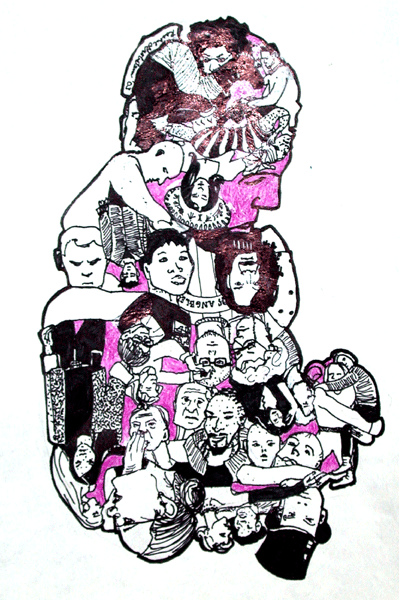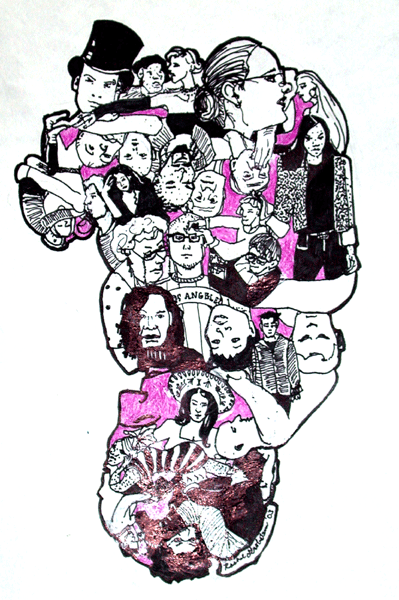Made available on Serendip
In association with Making Sense of Diversity: An Exploration, a world wide conversation

|
One People, Many Stories: Latina Identities
Participants
Summary
Prepared by Anne Dalke
Additions, revisions, extensions are encouraged in the On-Line Forum
| 
|
Chris and Yinette began our conversation by asking us to define the difference between the terms "Spanish," "Hispanic" and "Latina." "Hispanic" seems to be the "government-imposed" term, used for "box checking"; it is a word which "embraces the Spanish" portion of inheritance, but neglects the "other." "Latina" has a political valance; it is a self-chosen word drawn, strikingly, from European culture. There was also discussion of "Chicano," as a term specific to the experiences of Mexican-Americans (who say, "we didn't cross the border, the border crossed us"). It's important, in understanding the many stories of Latinas, to acknowledge their many distinctive identities; there are many different ways in which people become what they become. Puerto Ricans come from a U.S. colony; their experiences differ from those of Cubans, who were allowed into Miami with benefits, during the era of desegregation.
The shared experience of being colonized as the "other," as well as a history of "mixture," unites all Latinas. But how people came to the U.S. has a lot to do with their consciousness. Their migration stories are all different, as are their accents, their skin tones (which can range, within from family, from "dark wood to milk," and be the source of much tension), and the basis of their culture (generalizing widely: Caribbean cultures are largely African-based; Central America is largely indigenous, and South American more European). Latinas are known as "the cosmic race."
The English and the Spanish had very different ways of managing race. The English used the "one-drop rule" (having any Black ancesters defined one as Black). Spanish conceptions of race were much more fluid, with "buying into whiteness" a possibility. In both cultures, there was a strong desire to become white, to earn the privileges of white skin (one was applauded as one "got lighter," and told to "keep on coming"!) Conversely, one might be told, "you've got something in you." All the people in power, and all the media, in Spanish-speaking countries are light-skinned. Race and class are closely aligned.
Latinas are the largest people of color group in the U.S. Racial divisions and race consciousness are often developed, for Latina immigrants, in the United States. The concepts are institutionalized differently in their original countries (in the Dominican Republic, for instance, passports indicate skin tone, including categories of light and dark Indian). Based on countries of origin, ideals collide. There is empathy--as well as real stress--between Latinas and African-Americans. Mention was made of "self-selected blacks": Hispanics who do not consider themselves part of Black culture. Some Europeans admire the richness of Latina cultures, thinking they "have something we have lost in Europe," a "contact with the soil" that the "spread of macadam" prevents.
But how do we stop the old story, stop replaying the old ideas of race? We have a need for education: we need to get to know people, in order to learn that they are like us. Can we learn to identify with one another in less narrow ways? How can we expand the pie, instead of fighting over pieces of it? What role did Latina consciousness play in the recent discussions about disenfranchishment of women of color from the Student Government Association, and on campus more generally? A Marxist analysis was offered: "race is a brilliant conception--it divides people who would otherwise have come together."
Chris and Yinette distributed a list of recommendations for further reading about the Latina experience in the United States.
The discussion is invited to continue further in the on-line forum on "Making Sense of Diversity," and will resume in person at noon on Friday, April 1, when Sandy Schram (Graduate School of Social Work), Lauren Faber (07) and Diane Scarpa (06) will lead a discussion of "Red, Blue, Purple: Political Diversity."
| Return to Schedule for Friday Noon Conversations

| Bryn Mawr Conversations
| Archived
Forum
| Archive of Bryn Mawr Conversation
| General Conversation
| Serendip Home |
These pages are sponsored by the Bryn Mawr College Office
of Intercultural Affairs, the Center for Science and Society and the Serendip
website. Send us additional comments or suggestions at Serendip
© by Serendip 1994-
- Last Modified:
Wednesday, 21-June-2005 15:18:00 EST

